What is tahini? How do you use it? Is it nutritious? Today’s post is part of my Ingredient Guides series, where I do a deep dive into interesting, tasty and nutritious foods and ingredients. I will take you through all the basics of what tahini is, its nutritional profile, storage tips, cooking uses and more. Have you ever used tahini? Do you like the taste? Let me know in the comments!
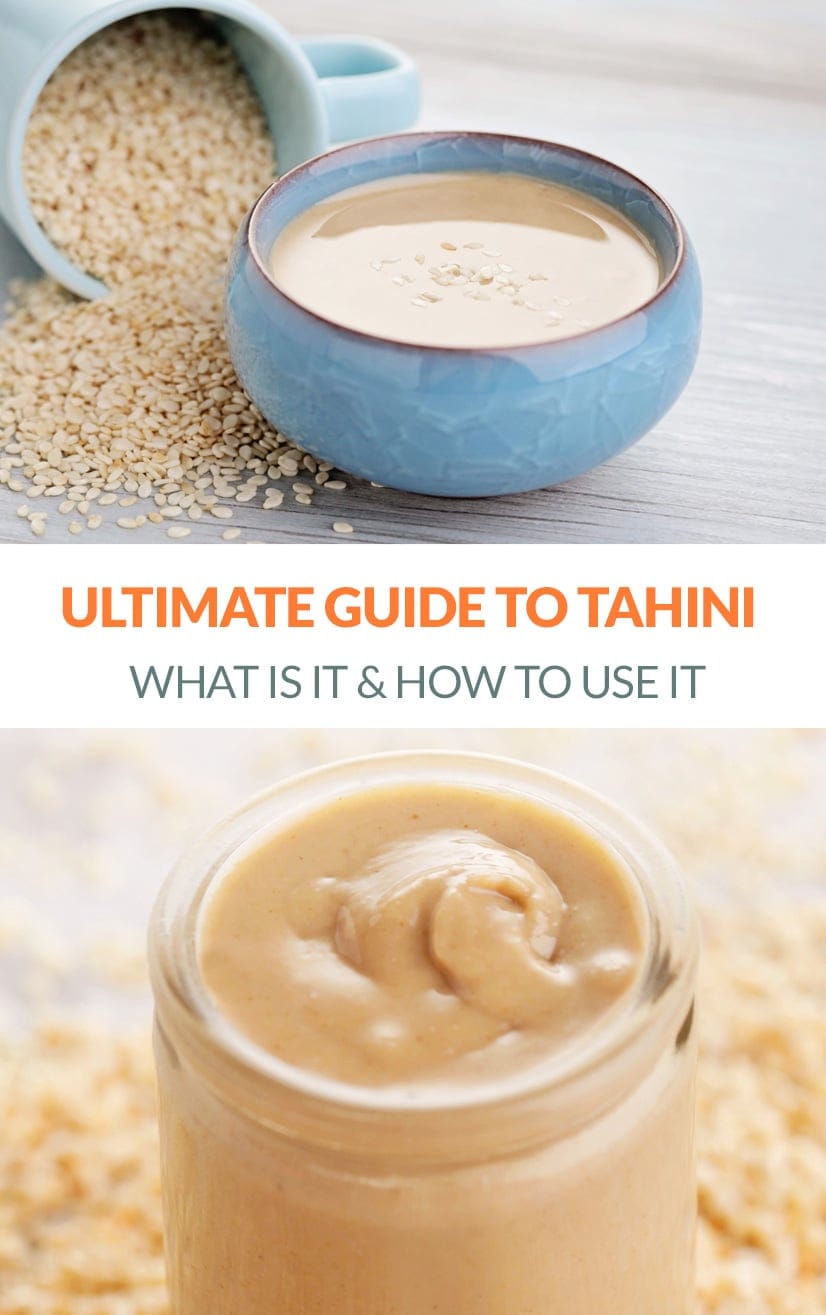
What Is Tahini?
Tahini is a delicious, smooth paste made of ground-up sesame seeds. First, the seeds are hulled (but not always!) and sometimes toasted for extra flavour before getting ground into a creamy consistency.
It is similar to any nut or seed butter, though it’s often used in savoury recipes like hummus rather than sweet like peanut butter. However, it is delicious with apple slices!
It is heavily used in Middle Eastern cuisine and is also popular in the Mediterranean and Northern Africa. It is nearly always used to make hummus and baba ghanoush. It also makes incredibly delicious dressings or sauces for salads, falafel, or grilled/roasted vegetables.
It is pretty easy to make at home if you have a high-speed blender or food processor. Have you ever tried making it at home? Stay tuned for a tahini recipe or leave a comment below sharing your favourite use for it!
What Does Tahini Taste Like?
Tahini has a similar texture to smooth peanut butter or almond butter, although it is a little bit thinner. It has a nutty, earthy flavour with a little bitterness and it doesn’t have the subtle sweetness almond or peanut butter has. The bitterness is part of its charm and versatility that works well in savoury dishes.
Tahini Nutrition
As it is made purely out of sesame seeds, tahini is vegan-friendly, Whole30, gluten-free, keto, paleo and nut-free. It is a single ingredient food, and it is safe for nearly all diets besides for people who are allergic to sesame seeds. This allergy is not as common as other types but if you do have other preexisting nut or seed allergies, a sesame seed allergy is possible, so be aware. Here is a quick nutrient breakdown:
Per 1 tablespoon of tahini (15 grams)
Calories: 90 kcal
Fat: 8 grams
Carbohydrates: 3.2 grams
Protein: 2.6 grams
Fibre: 1.4 grams
Sugar: 0.1 grams
Sodium: 17 mg
Potassium: 62 mg
Iron: 7%
Magnesium: 3%
Phosphorous: 11%
Calcium: 6%
Tahini Benefits
Let’s go over a few health benefits of tahini.
It’s Rich In Fatty Acids
The Mediterranean diet has been widely approved by health experts because it is rich in monounsaturated fatty acids (MUFAs), which are plentiful in sesame seeds and tahini. These fatty acids are a powerhouse of benefits including the ability to improve lipid profiles in the blood, insulin sensitivity improvement, normalising glucose levels, and regulating blood pressure. They may even reduce the risk of obesity (1).
Both MUFAs and polyunsaturated fatty acids (PUFAs) have been linked to lowering LDL cholesterol (2). This may ultimately link regular consumption by reducing the risk of heart disease.
As with other types of fats, there are caveats and nuances. Sesame seeds and subsequently tahini are also quite high in polyunsaturated fatty acids (PUFAs) and specifically in omega-6 fatty acids. It’s an essential fatty acid, which means our bodies require it but can’t produce it. We need it just as we need omega-3 fatty acids found in oily fish, leafy greens, chia seeds and flaxseeds. While we need both, it’s about balance.
Too much omega-6’s and not enough omega-3’s can have a pro-inflammatory effect. Does that mean tahini is pro-inflammatory? No, not in the context of a balanced diet. If, however, you are actively trying to bring down your omega-6 fatty acids, then just beware that tahini is a rich source. Having said that, its benefits might outweigh this.
Phytosterols In Tahini
Sesame seeds – as well as wheat germ – are the most abundant food sources of phytosterols at 400-413 mg per 100 grams (3). Phytosterols are molecules similar to cholesterol found in plants. In the diet, they are most commonly found as campesterol, sitosterol, and stigmasterol. The evolution of the western diet leaves us needing more phytosterols for their benefits (4).
First, phytosterols can have a positive impact on LDL cholesterol just like the fatty acid composition of tahini. This is because it inhibits the absorption of bad cholesterol – or alters metabolism (5).
For optimal results in this regard, it is recommended to have a dose two times per day (6). 1.5-2 mg per day is reasonable and beneficial for cholesterol. Again, it is important to keep LDL low because it subsequently decreases the risk of coronary heart disease.
Antioxidants
Lignans – a group of polyphenols or antioxidants. If you’re familiar with flaxseeds and their health properties, lignans are a major contributing factor in those claims. Lesser known is that sesame seeds contain a similarly high amount! While there is a lot of research that still needs to be done, lignan benefits are promising – particularly in the case of sustained and regular consumption (7). High doses of lignans may reduce cardiovascular risk (8).
One of the specific lignans found in sesame seeds is called sesamin. We see more benefits if we look closely. In one study, ingestion worked for “improving blood lipids, antioxidant status, and possibly sex hormone status” in post-menopausal women (9). Another study concludes that sesamin provides anti-hypertensive benefits thereby reducing blood pressure and decreasing the risk of cardiovascular disease (10).
Magnesium
Magnesium is an important mineral with a good deal of health benefits. Considering two tablespoons of tahini (the serving size) provides 6% DV, it’s worth mentioning some of the positive side effects. Magnesium has been shown to positively affect both systolic and diastolic blood pressure alongside a balanced spectrum of other vitamins and minerals (11,12). However, “Magnesium had the strongest association with blood pressure” (11). We also need magnesium for calcium to do its job properly.
Most people in the U.S., France, and most developed countries do not receive enough magnesium in their diets according to research, so it’s always good to keep track of foods that can up our dosage (13, 14).
Iron In Tahini
Tahini is a good source of iron, especially for vegans and vegetarians who are far more likely to be deficient (iron is most abundant in meat). Iron deficiency can cause anaemia and we need it for proper oxygen transportation around the body, which is why you should ensure that you’re taking in enough.
Moreover, iron absorption is difficult with plant-based food due to inhibiting factors such as phytates (15). Vitamin C helps to absorb the iron, so tahini with lemon juice is a good call!
Calcium
Tahini and sesame seeds are very high in calcium but it comes with another caveat. Sesame seeds are also high in oxalates. This is a relatively harmless compound, but it does impact the absorption of minerals such as calcium. While tahini is high in calcium, the body can’t absorb all of it (16).
Hulled vs. unhulled tahini
Most store-bought brands labelled tahini or light tahini will be made from hulled seeds. This means the seeds will be removed before preparation. Then, the seeds will be roasted and ground into tahini. This is the most common production method. If you were to make your own tahini, you would likely have an easier time finding hulled sesame seeds. Hulled sesame seeds are often a lighter colour – nearly white.
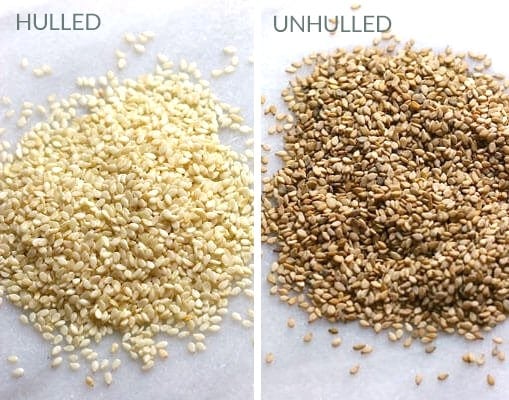
Unhulled tahini is made from sesame seeds that have their shells still on and is often referred to as sesame butter or dark tahini. This product is considered more nutritious but by a small margin.
Unhulled seeds are also more fibrous. This makes sense if we draw the same comparison to whole-grain bread versus white bread.
Whole grain bread uses the entire grain as the name suggests, so it doesn’t need to be fortified after processing. However, unhulled tahini tastes significantly more bitter and has a gritty texture which may turn some people off. Unhulled sesame seeds are often a darker colour, and more brown than creamy white.
Where To Buy Tahini
Tahini can be found at most grocery stores including big box grocers and world markets in my experience. It is typically found in the ‘ethnic’ food aisle. And you can definitely get it on Amazon and other online stores. As it grows in popularity, you will find it amongst the nut butter as well – especially at health food stores. The most versatile type of tahini is light, hulled tahini so I recommend you start with that if trying it for the first time.
How Long Does Tahini Last?
Store-bought tahini should always be kept in an airtight container (usually its jar and lid). Storage makes a difference in how long it will keep and how it tastes.
Unopened, tahini keeps for many months, but the oils will go rancid over time. Like other nut and seed pastes, expired tahini has a musty, stale smell and tastes noticeably bitter and funky. I would not keep unopened tahini for longer than 6-12 months.
Once opened, tahini can be kept in a cool, dry pantry (4-6 months) or the refrigerator (6-12 months). When tahini is unused for a while, the oil will usually surface to the top. Make sure to stir it before using.
Homemade tahini must be refrigerated, and it will last up to one month in a covered container.
How To Make Tahini At Home
Making tahini at home is a breeze if you have a food processor. You could feasibly use a mortar and pestle as well, but you will certainly be working harder and the result will not be as smooth and creamy.
Ingredients:
- 1 cup of sesame seeds – hulled is preferable
- 3-4 tbsp. avocado oil or olive oil (depending on desired consistency)
- Salt to taste
Instructions:
- Toast sesame seeds lightly in a skillet without oil. Simply toss them on medium heat stirring often until they are fragrant, being sure not to burn them. This should take 3-5 minutes.
- ALTERNATIVELY, you can toast them in the oven on a non-stick pan. Bake for 10 minutes at 176C (150F).
- OPTIONAL: Use a mortar and pestle to begin grinding sesame seeds.
- Add sesame seeds to a food processor and blend until paste forms. You will likely have to scrape the sides a few times or mix things up.
- When the seeds become pasty, add in the oil. Blend until you get to the desired consistency.
Add salt and blend in to taste.
Black Tahini
The black tahini is the same thing – ground-up sesame seeds – made using black sesame seeds. There are several colours of a sesame seed, it turns out, including red and brown. Black sesame seeds are common in Japan and notably more bitter.
The hulls of the seeds themselves are black, and if you remove the hulls, the sesame seed will be white! The taste can be described as toasty, burnt, or wood-fired. However, if you adore the taste of sesame seeds, you are sure to love this variation with a super savoury essence and many unique uses. This is for the true foodie and adventurous eater.
You can find a recipe here from Serious Eats.
Tahini Substitute
Tahini can easily be substituted for most recipes. In savoury recipes, I would recommend using sunflower seed butter, cashew butter, or brazil nut butter. Likewise, in savoury or particularly sweet recipes, you can use peanut butter or almond butter. The key is maintaining the same nutritional composition and texture when using it in most recipes, as tahini is often used in relatively small quantities. In a pinch – or case of an allergy – any nut butter will yield similar results.
Recipes With Tahini
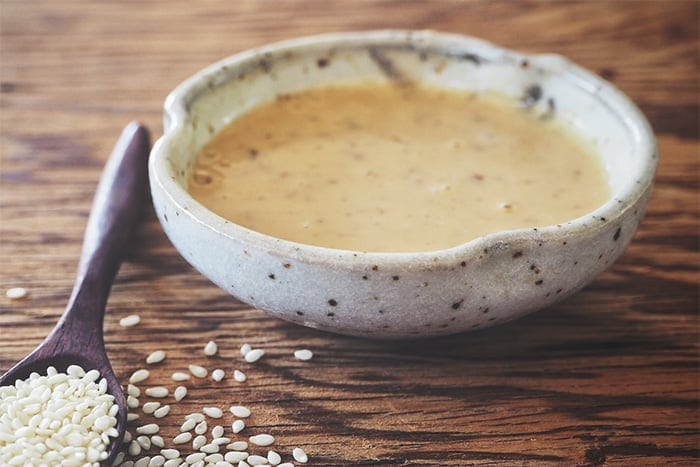
Tahini is often used to add a nutty, earthy and slightly bitter flavour to a dish or a condiment. It is also used to thicken sauces, dips and dressings.
It works in savoury and sweet recipes and pairs well with lemon, yoghurt, garlic, salt, eggplant, cauliflower, and sweet vegetables like pumpkin and sweet potato or fruit like pomegranate and apples.
Want to Save This Recipe?
Enter your email & I'll send it to your inbox. Plus, get great new recipes from me every week!
By submitting this form, you consent to receive emails from Cooked & Loved
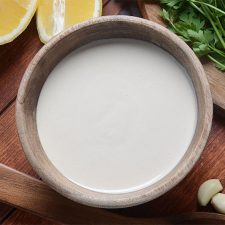
Ingredients
- 150 g light tahini paste
- 120 ml water
- 2 tablespoons lemon juice
- 1 medium garlic clove crushed or grated
- 1/4 teaspoon salt
Instructions
- Before starting, stir the tahini paste in its tub, scraping the bottom with a spoon as the fat and solids tend to separate.
- Combine all ingredients in a mixing bowl and stir until you get a thick sauce, the consistency of clear honey. Add a couple of extra drops of ater if you need.
- Store in a jar in the fridge for up to w week Stir to loosen before using, adding a little more water if needed.
Notes
Nutrition
More Recipes Using Tahini
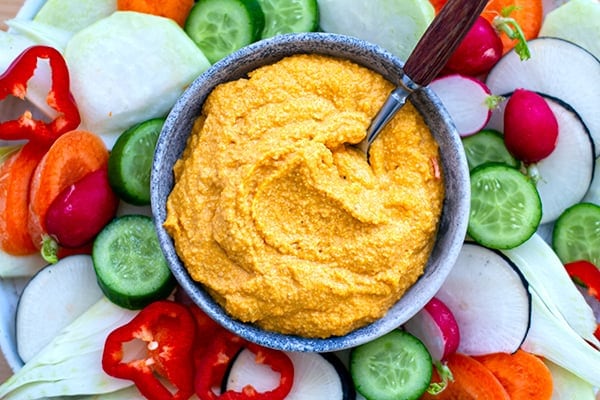
Pumpkin tahini & cashew hummus dip
Roasted squash salad with garlic & tahini dressing
Classic chickpea hummus from Bon Appetit
Dukkah pumpkin, beef & rocket salad with tahini dressing
Baba ganoush from The Minimalist Baker
Chipotle tahini from Pinch of Yum
Vegan no-bake cookies with tahini from A Couple Cooks
Roasted cauliflower salad from Budget Bytes
REFERENCES
2. A changing role for dietary monounsaturated fatty acids
3. Phytosterol composition of nuts and seeds commonly consumed in the United States
4. Phytosterols
5. Dose effects of dietary phytosterols on cholesterol metabolism: a controlled feeding study
6. LDL-Cholesterol Lowering of Plant Sterols and Stanols-Which Factors Influence Their Efficacy?
8. Dietary lignans: physiology and potential for cardiovascular disease risk reduction
9. Sesame Ingestion Affects Sex Hormones, Antioxidant Status, and Blood Lipids in Postmenopausal Women
10. Antihypertensive Effects of Sesamin in Humans
12. Effect of magnesium on blood pressure
13. Dietary Magnesium Intake in a National Sample of U.S. Adults
14. Dietary Magnesium Intake in French Adult Population
15. Review on iron and its importance for human health
16. Is it true that plant foods are a better source of calcium than dairy foods?


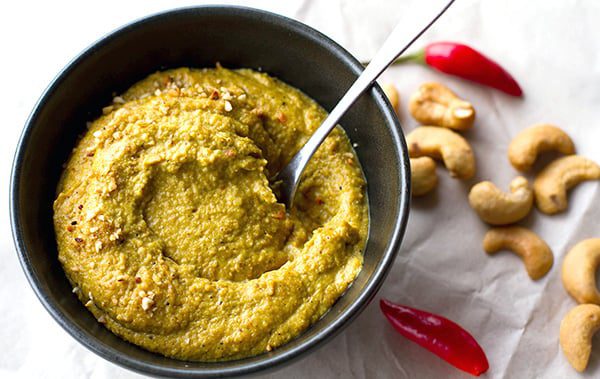
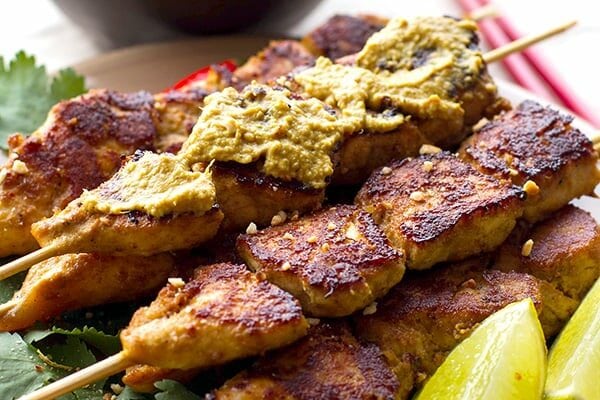
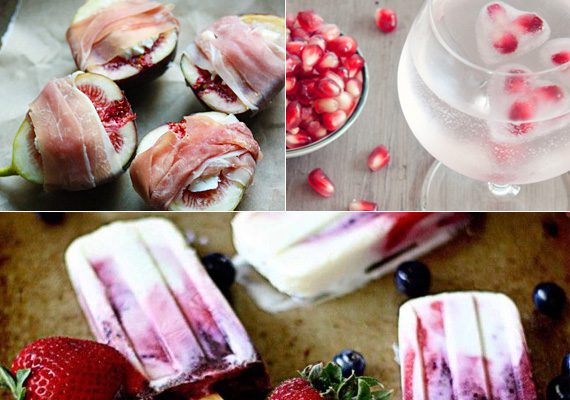
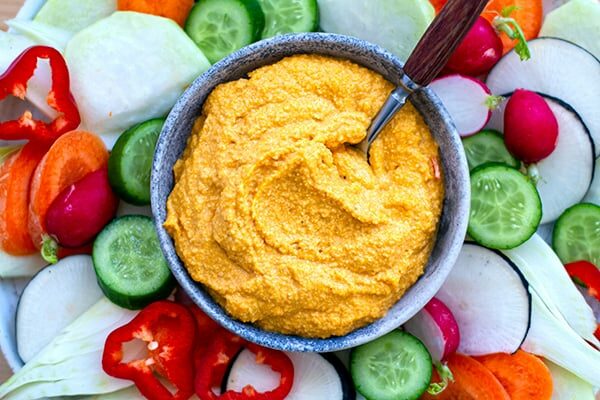
Hi
I’m from and country where 30 degree is the average temperature all year around. How long can I store tahini sauce, and does it need to be refrigerated since water and lemon juice are added.